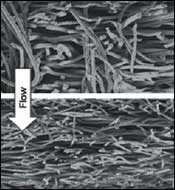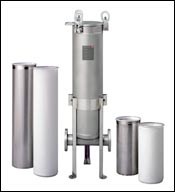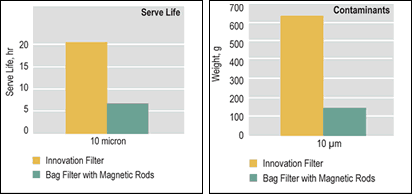Stronger Than Dirt
Novel filtration system improves e-coat performance
#pollutioncontrol
It is commonly known in the automotive industry that many surface defects are caused by poor cleaning of vehicle bodies before application of an electro-deposition coating. For example, oils and greases are known to cause “craters,” and metal fines greater than 40 µm in size are visible to the human eye, resulting in surfaces having to be reworked. Rework is not only costly and labor-intensive, but the appearance, particularly of metallic finishes, is never quite the same as that of a body that required no rework. The result is reduced customer satisfaction.
Even worse, oils, greases and metal debris (“weld balls”) not only cause paint surface defects, they can also result in serious corrosion problems if they are not removed before pretreatment and electrocoating. Phosphate pretreatment uniformity and weight depend on the metal being totally clean. These problems, in turn, result in a higher level of warranty claims and subsequent reduction in profitability as well as quality reputation for the automotive companies.
Featured Content
Filter bags inserted in canister filter housings are commonly used to remove particulates from various fluids in the pretreatment and electrocoating of auto body components and other parts. However, many users encounter a number of problems with bag-filtration systems in these areas.
The ability of a filter to retain a contaminant—that is, its efficiency—can be expressed as the ratio of the concentration of a contaminant in the feed stream to the concentration of it in the effluent. One major factor in lower filtration efficiency is the stitched seam of many filter bags. For example, the filter medium may be rated as 1-µm; however, the sewing needle used to stitch the seam may be 100–150 µm in diameter. This, in turn, means pores along the seam are in fact far greater than the rated filter bag.
Additionally, the standard filter bag is not fully supported—the bag does not conform exactly to the shape of the support basket. Because the standard filter bag is generally longer than its support basket, the unsupported part of the bag (the bottom area) can burst. If this happens, it will release a large volume of contaminants downstream.
Improved Filtration
DuoFLO is a new, patent-pending filter system developed by CUNO Inc. to solve some of these problems. Using a unique flow path, the filter cartridges consist of two porous cylinders ultrasonically-bonded to rigid top and bottom plates. The fluid enters through flow channels in the top plate then flows between the inner and outer cylinders, which are composed of two “sleeves” of filter media. The fluid then flows through both “sleeves” into the closed chamber of the housing.
The high-performance fibrous media used in this innovative filtration system is made up of an open, porous pre-filtration layer integrated with a more efficient final layer. This gradient-porosity medium has greater capacity and longer service life before it plugs with accumulated solids than an equally thick homogenous medium. The two-sleeve construction results in a 62% increase in surface area compared to standard filter bags. This, in turn, reduces the flux (volumetric flow rate/area of medium), which leads to a decrease in initial pressure drop, increased dirt-holding capacity and improved efficiency.
Advancing depth filtration
The technology used to manufacture the filter cartridges provides a high degree of fiber-to-fiber thermal bonding, without the use of binders, to produce a rigid, coreless filter structure that does not unload contaminants with increasing differential pressure, allows machining of grooves into the upstream surface without tearing or melting the filter structure to provide more effective surface area and exhibits exceptionally low differential pressure for a given filter rating.
Flexible structures such as those found in conventional melt-blown and string-wound filters, on the other hand, tend to compress and change porosity with increased pressure. Compression can result in short filter life because the pores collapse and ultimately close.
On the Line
It all sounds good in theory, but how does the system work in practice? One automotive assembly plant that wanted to improve the quality of its pretreatment fluids, in particular the cleaning tank and the city water spray rinse after cleaning, ran a trial to find out.
Plant managers first collected baseline data for their existing filter-bag system. The system used magnets inserted in each filter bag to boost efficiency and extend filter service life.
After the baseline data was collected, workers installed the new filter elements. Process conditions were identical, but except no magnets were used with the new filter elements. Both filter systems were run continuously 24 hr/day, five days/week. Workers changed out filter elements when differential pressure reached 10–12 psi. Standard stainless steel baskets supported each standard filter bag, and stainless steel baskets were installed to fully support each new filter element.
In the cleaning tank, the plant used a typical alkaline immersion cleaner blended with city water. Filter housings were standard #2-size bag housings, and the standard filter bags were 10-µm nominally rated, polypropylene filters. At least one magnetic rod was inserted in each filter with two magnets installed in the upstream fluid within the housing.
Conditions were similar for the city water spray rinse: #2-size bag housings with filter baskets with 10-µm nominally rated polypropylene filter bags. Again, at least one magnetic rod was inserted in each filter and two inserted in the upstream fluid within the housing.
Six-Month Study
Plant engineers collected information on filter element service life, weight of contaminants trapped per filter, filter integrity, average daily hood dirt counts, and ease of use, as well as operators’ comments on differences between both filtration systems.
Engineers defined the end point of filter service life as the point when the differential pressure across the housings reached 10–12 psi. Line operators recorded differential pressures hourly.
To determine the weight of contaminants trapped per filter, each filter bag or element was weighed and indelibly marked for future identification before installation. After reaching the 10–12 psi differential pressure that marked the end of its useful life, each spent filter was removed from its housing. Metal fines from the magnetic rods inserted in each of the bag filters were scraped into the corresponding bag, and then filters were fully dried and reweighed. The difference between the weight of the unused filter and the dried spent filter was recorded as its dirt-holding capacity.
Operators evaluated filter integrity by documenting whether or not the filter element or bag had burst while in service or if there were any problems in insertion or removal.
To compare part quality, an experienced inspector examined the hood of each vehicle exiting the electrocoat system curing oven. The total number of hood “dirt” counts per day was divided by the number of vehicles processed on that day. This average daily hood “dirt” count was recorded for a total of six months—three months using standard bag filters and three months using the new filtration system. The average daily hood counts were normalized, that is, the bag filters’ average daily hood dirt count number was assigned a value of 1.0.
Operating Results
On this e-coat line, the new filter elements outperformed standard bag filters in every way. In the cleaning stage, they lasted on average 21 hr—3.3 × longer than the standard filter bags, which lasted an average of 6.4 hr.
In the rinse stage, the service life increase was even more impressive. The new filters lasted 5.3 × longer than the standard filter bags—and average of 50.8 hr, versus only 9.6 hr for the standard filters.
The longer service life of the innovative filtration system can be attributed, in part, to the lower flux through this filter. Another factor contributing to the longer service life of the innovative filters is the graded-porosity construction of the media. This type of construction increases dirt-holding capacity over homogenous (non-graded porosity) materials.
In terms of filtration performance, the innovative filters again outstripped the standard units, retaining more dirt even without benefit of the magnets installed in the conventional filter bag system. On a weight basis, the innovative filter elements installed in the cleaning stage trapped an average of 633.7 g/filter or 4.8 × more than the 133.3 g/filter trapped by the bag filter/magnet setup.
Results in the rinse stage were even more striking. The innovative filter elements held 6.5 × more “dirt” on a weight basis—an average of 307.2 g/filter, versus only 47.4 g/filter for the bag filter/magnet setup. Contaminant removal rate (weight of contaminants/time) was 6.06 g/hr for the new filter elements, whereas the rate for the filter bag/magnet system was only 4.9 g/hr at this stage.
The new system also exhibited better filter integrity than conventional filter bags. Several of the standard bags burst during baseline data collection. This is an indication that some of the filter bags either could not sustain start-up conditions, when the flow to the housing is suddenly introduced after a filter change-out, or that differential pressures got too high and seams burst. In contrast, none of the innovative filter elements burst, most likely because their patented design allows the basket to fully support the filter media.
There was a striking reduction in hood “dirt” defect counts after the innovative filtration system was installed. For example, defect counts dropped precipitously and they remained extremely low throughout the remaining three months of the trial. There was over 87.1% reduction in the average daily hood “dirt” counts while this novel filtration system was in service as shown in Figure 9.
Inspection of hoods for dirt defects revealed that the filter bags, even though they had relatively short service lives, were less efficient at removing “dirt” than the new filtration system. The DuoFLO filter elements were able to consistently maintain cleaner tank fluids which, in turn, accounted for at least a seven-fold reduction in hood “dirt” counts. Quality was also improved because the innovative filters lasted much longer than standard filter bags between change-outs. And, besides removing more particulates from each stage, the innovative filter elements also trapped crater-causing oil.
The Bottom Line
After reviewing the results of the six-month trial, plant managers adopted the new filtration system in all filtration stages in both their pretreatment and electrocoat processes. They discovered within a matter of a few months that the filters lasted longer between change-outs, which in turn reduced not only labor costs but also filter disposal costs. Additionally, they were able to reduce filter pore sizes for various stages to cut defect rates even further while still not increasing labor costs. In fact, they saved more than $160,000 the first year using the innovative filtration system.
Instead of frequently changing out filters, e-coat system operators now spend their time making the process more robust—cleaning nozzles, ovens and so on. Because the innovative filtration elements are more predictable and last so much longer, shift scheduling is easier. This allows certain maintenance work to be performed during the week rather than on weekends.
Use of the new filters also eliminated the need for “oil logs” in the e-coat tank. In the past, these were needed to absorb oils from this tank. Once the plant began using the new filter elements, they had no need to purchase these expensive items.
Further savings resulted from reduced filter usage, because the innovative elements lasted more than five times longer than standard filter bags. Additionally, less inventory of filter elements is required, freeing up storage space and reducing inventory costs.
And those are just operating savings. This doesn’t take into account improved paint system quality as measured by the dramatic reduction (87.1%) in hood “dirt” counts. Defects caused by these particulates can be a source of future warranty claims, so savings realized by converting to the innovative filtration system was probably greater than $160,000 in the first year.
RELATED CONTENT
-
Improving Transfer Efficiencies in Coating Operations
There are many methods for addressing electrostatic grounding in metal painting processes, and Tim Ulshafer from Mueller Electric says the best method for your process is a simple and worthwhile exercise.
-
Drivers of Change
Is your metal finishing software ready for an upgrade?
-
Pretreatment for Painting
Better adhesion, enhanced corrosion and blister resistance, and reduced coating-part interactions make pretreatment a must.






















